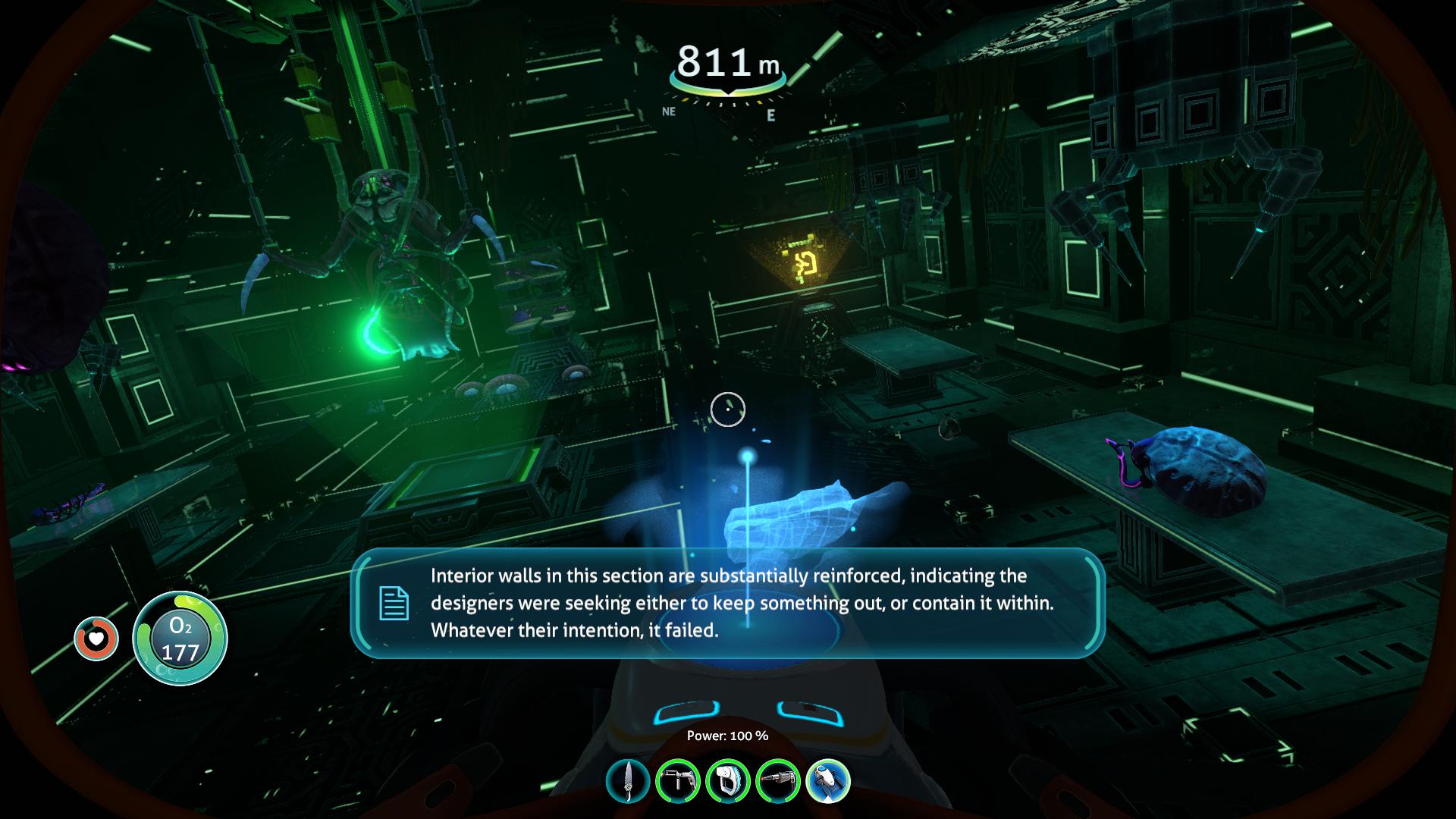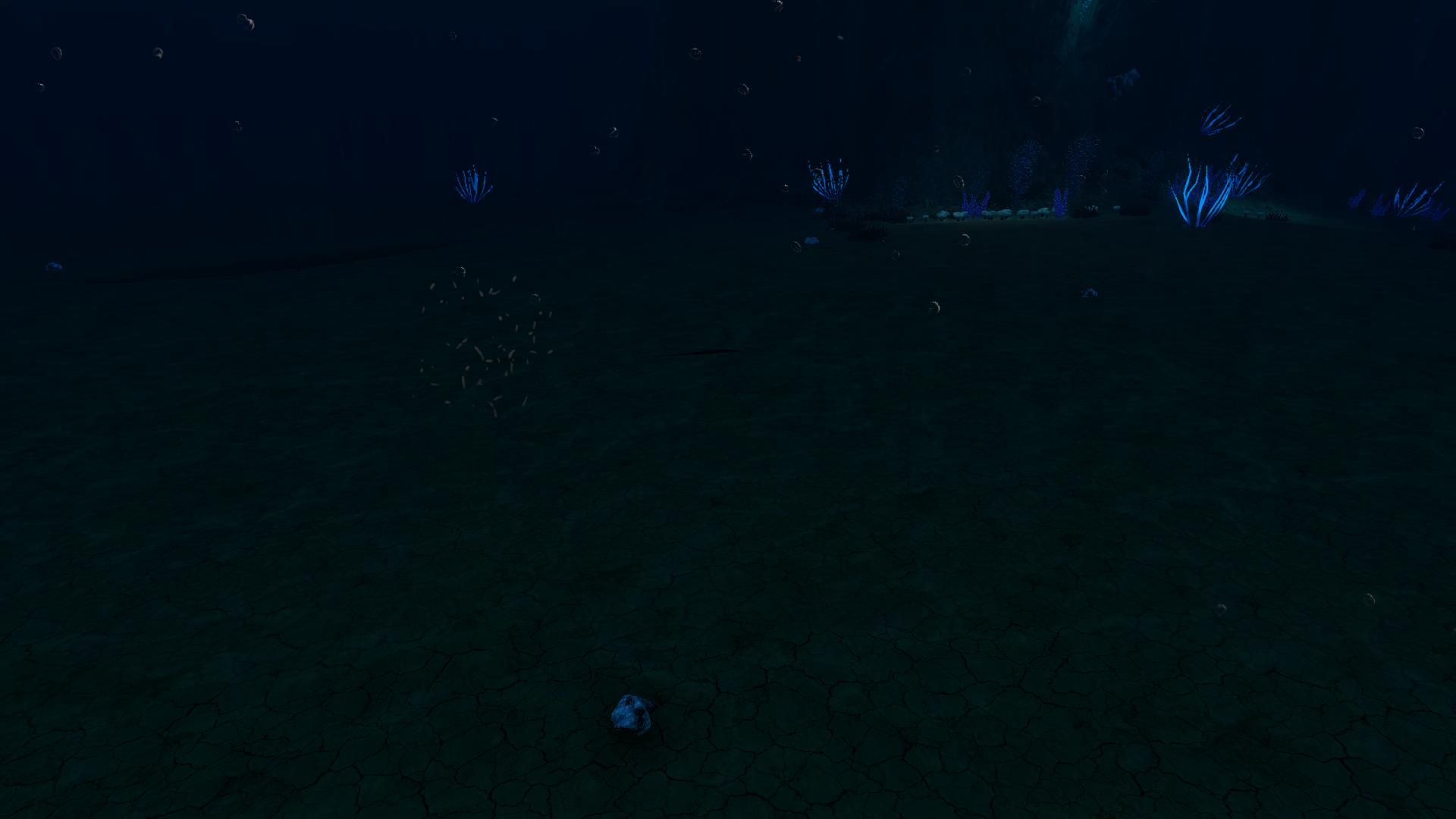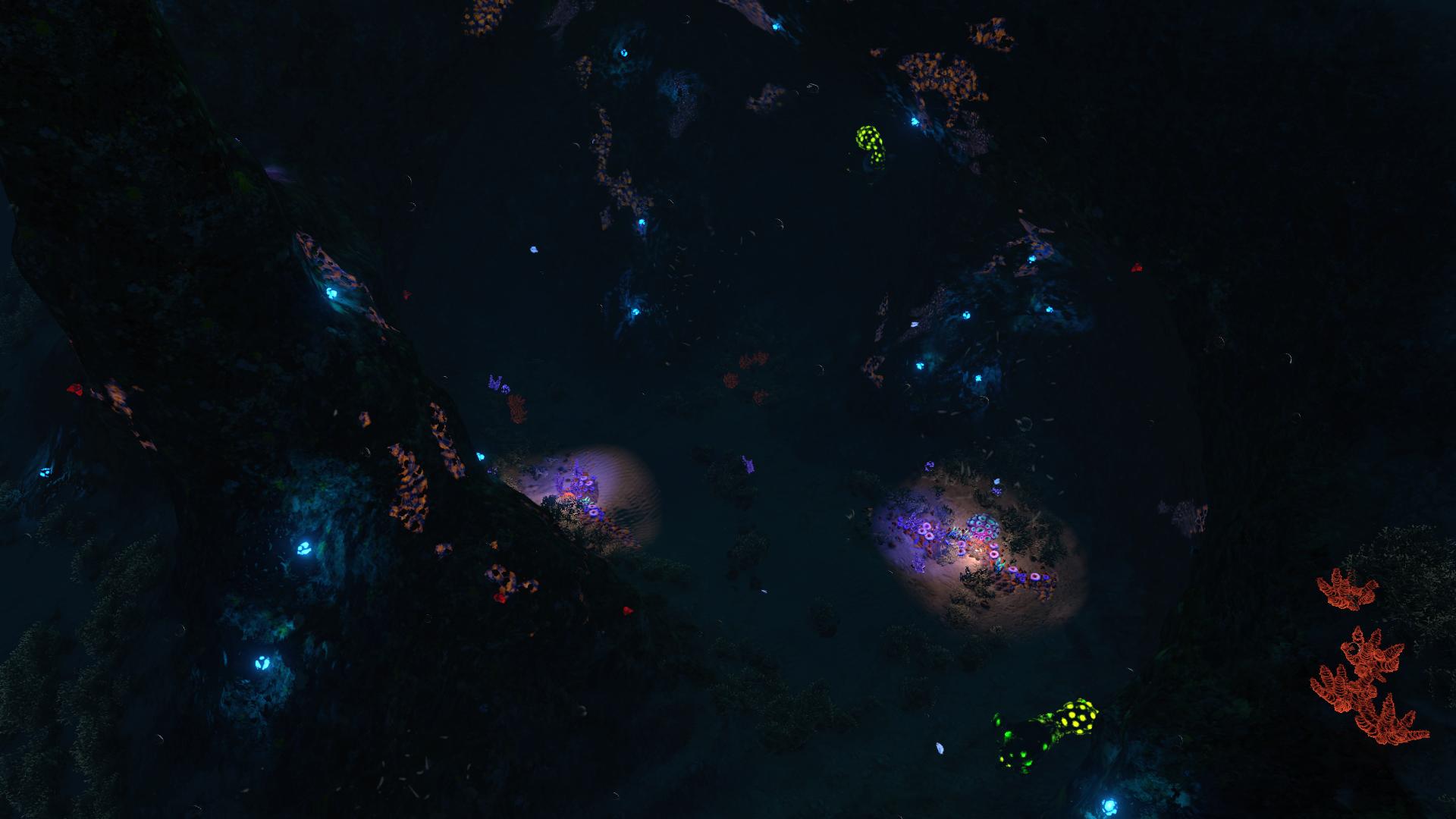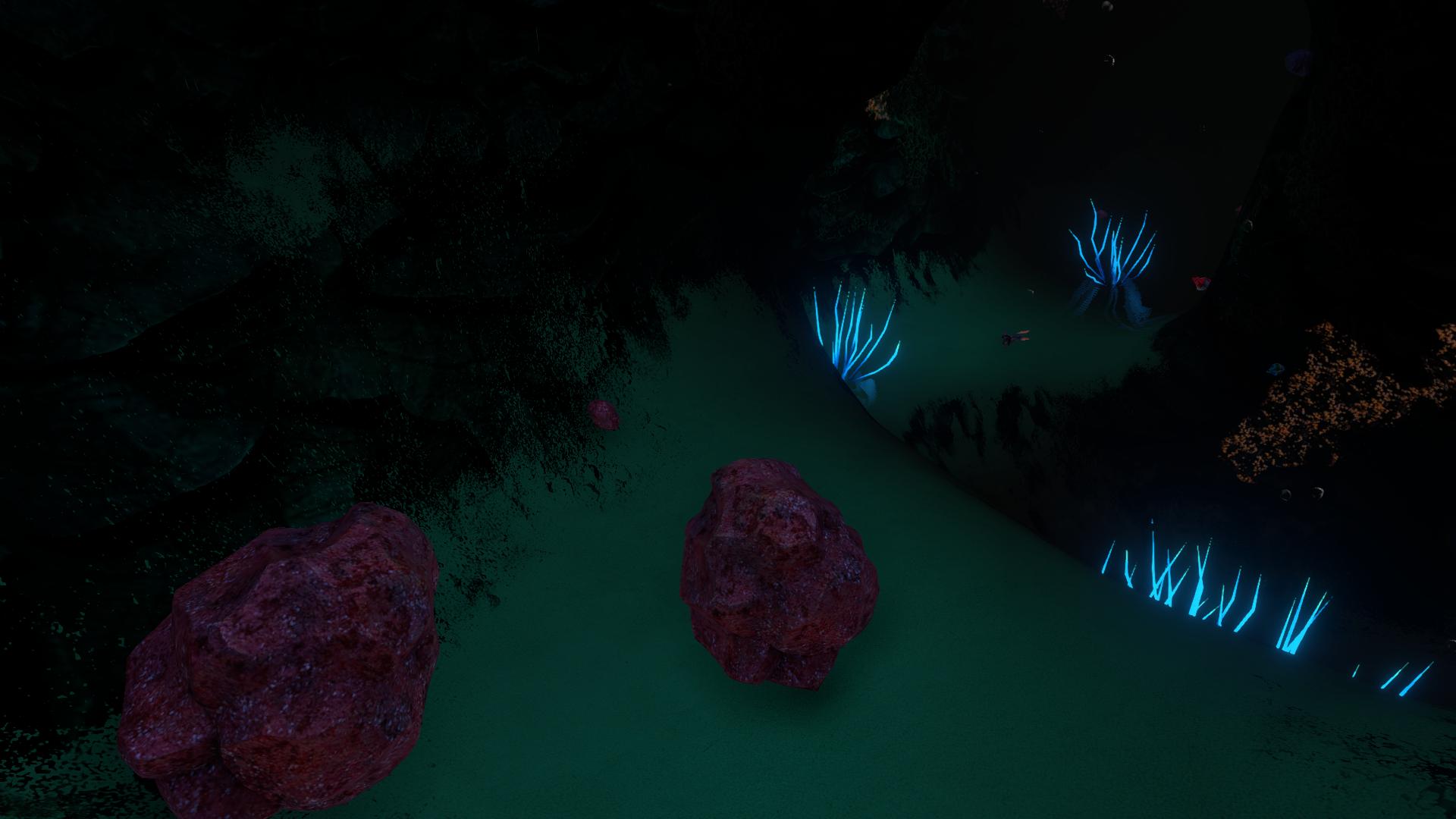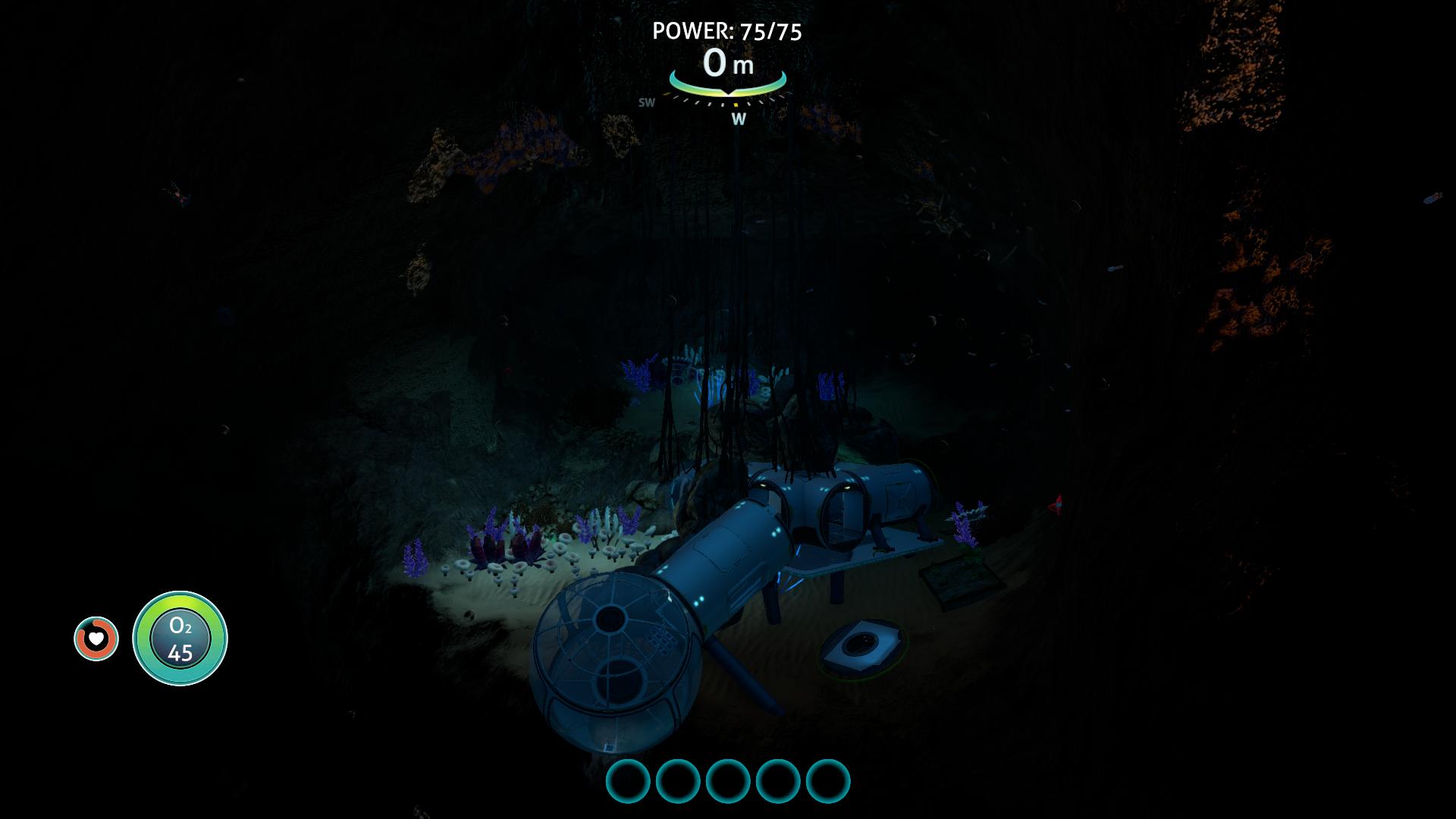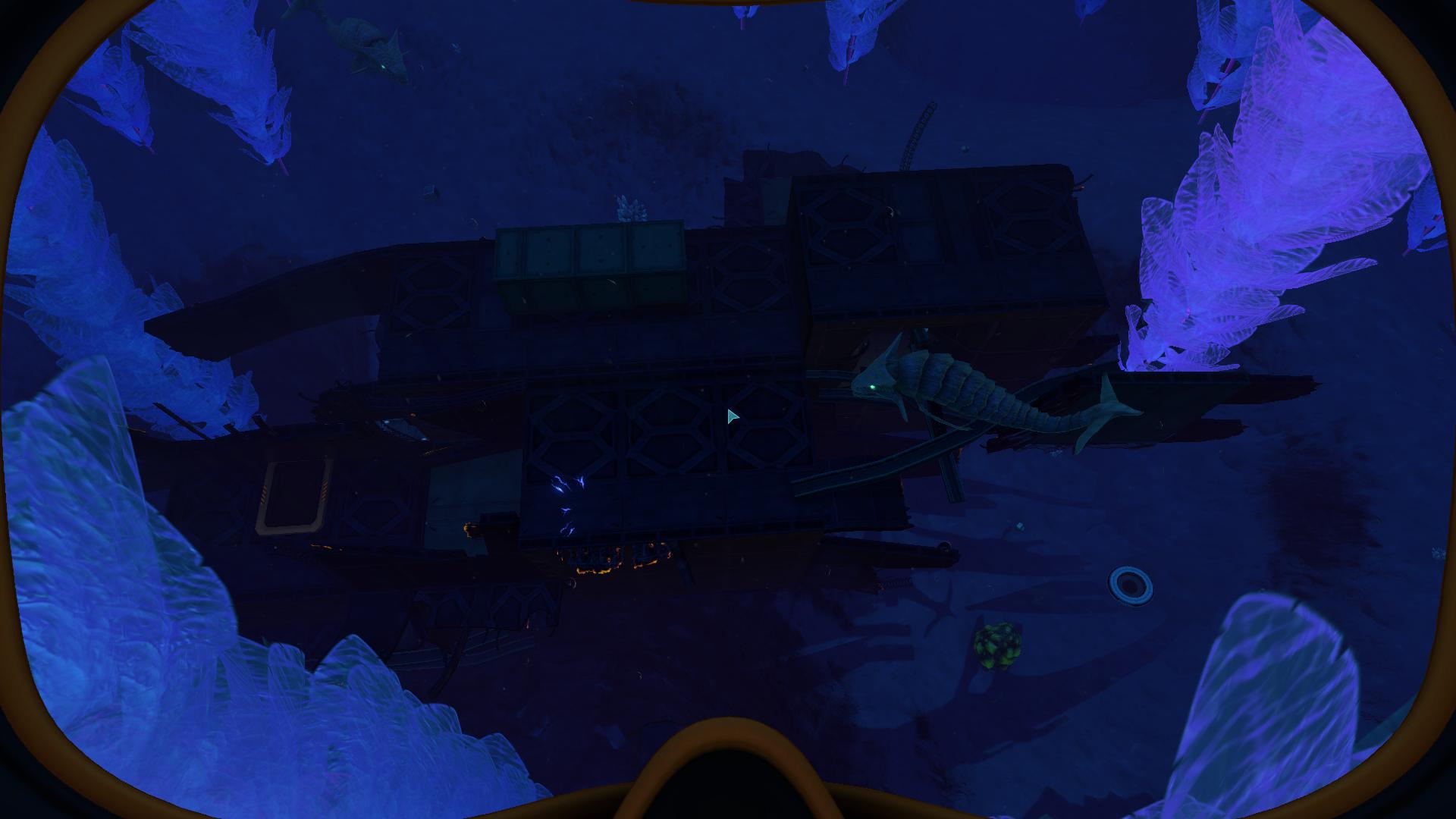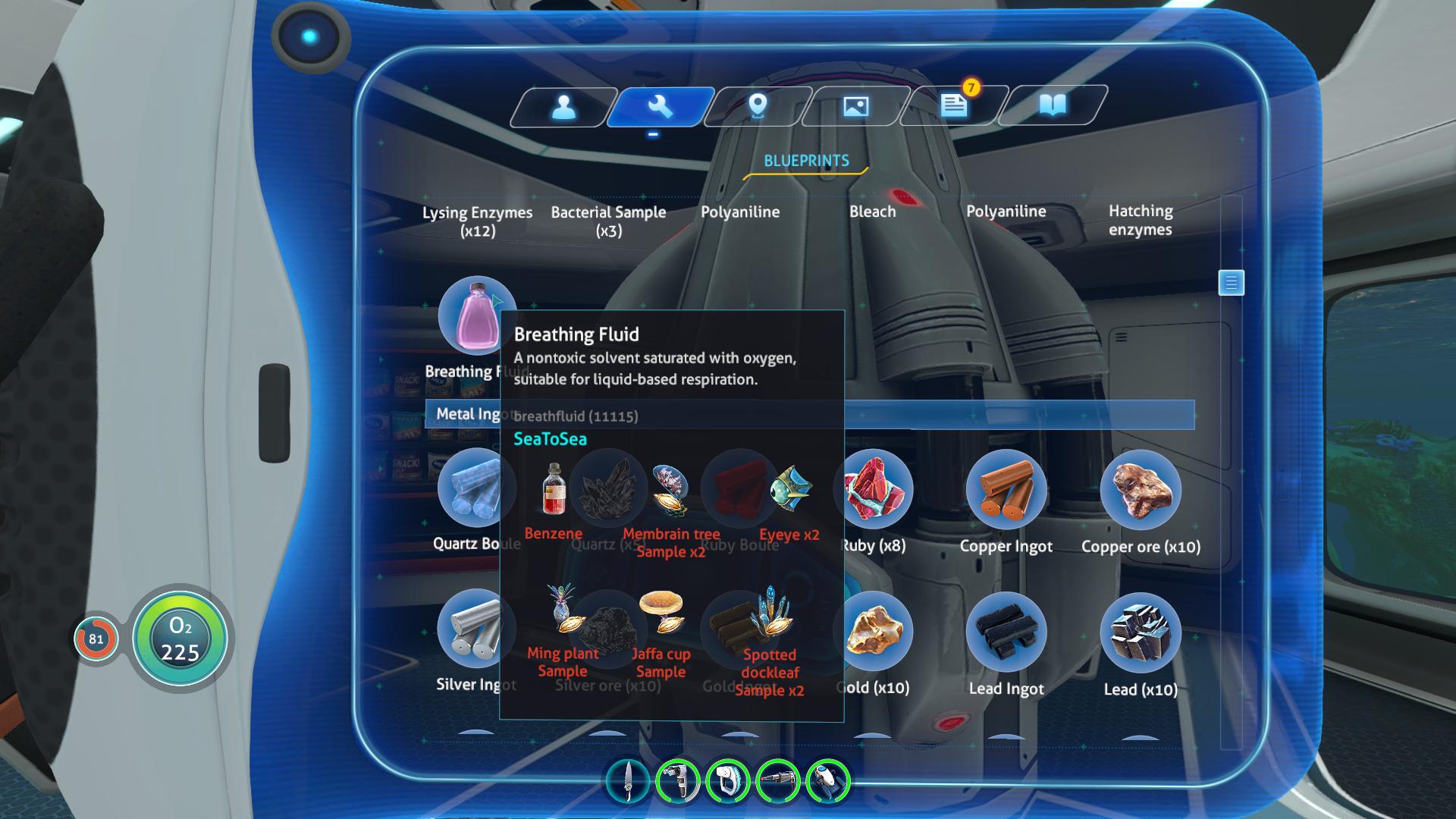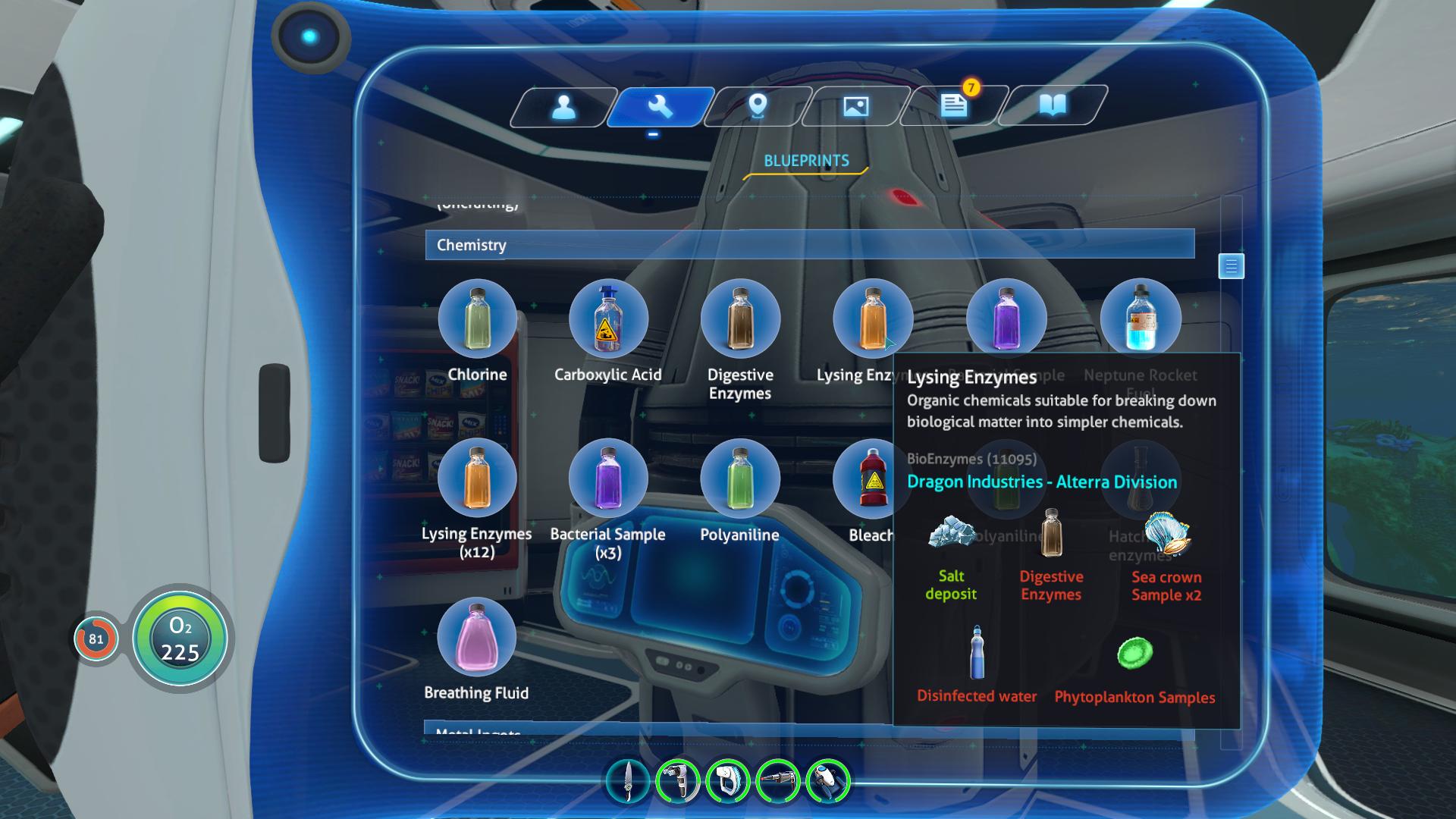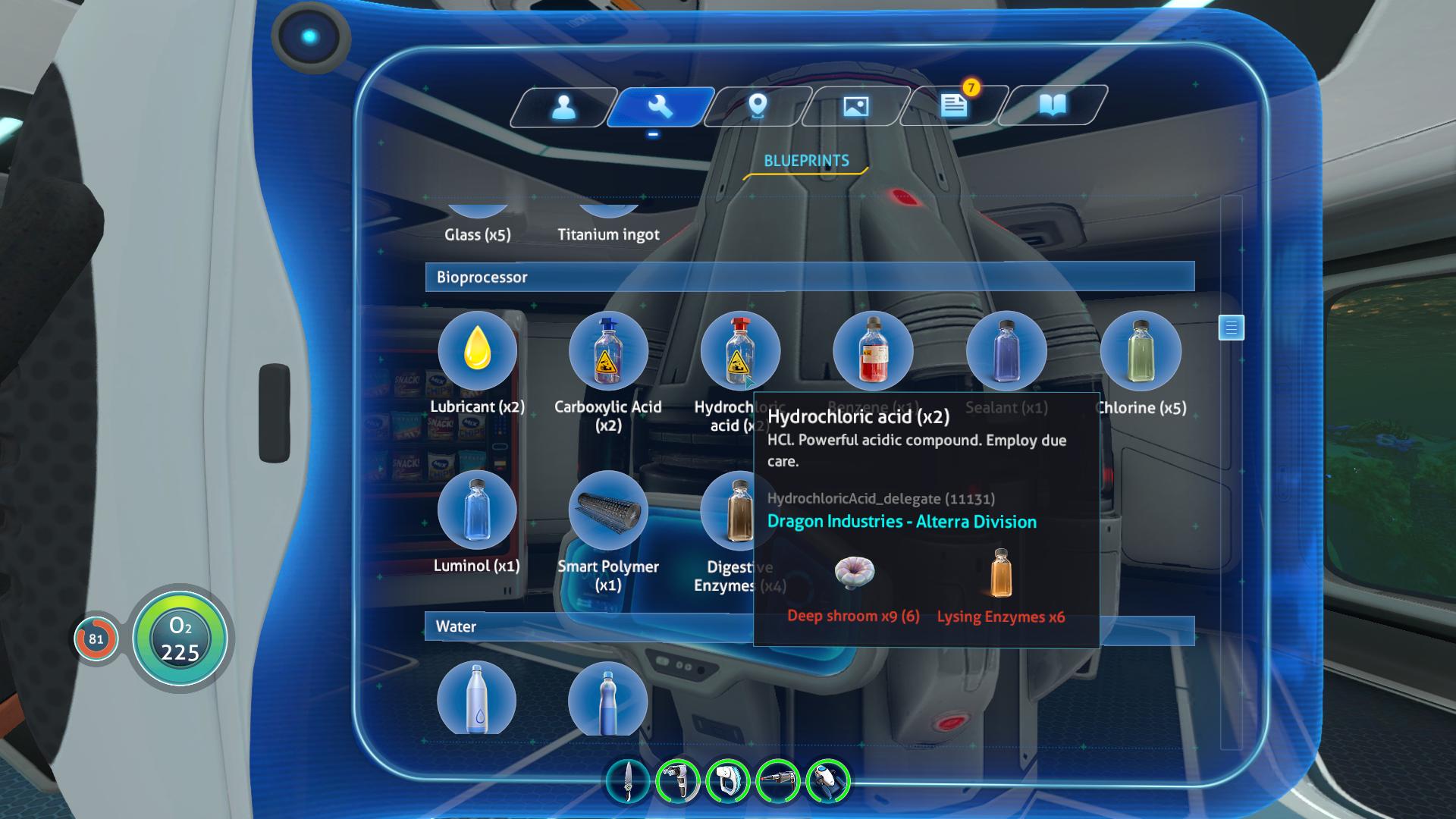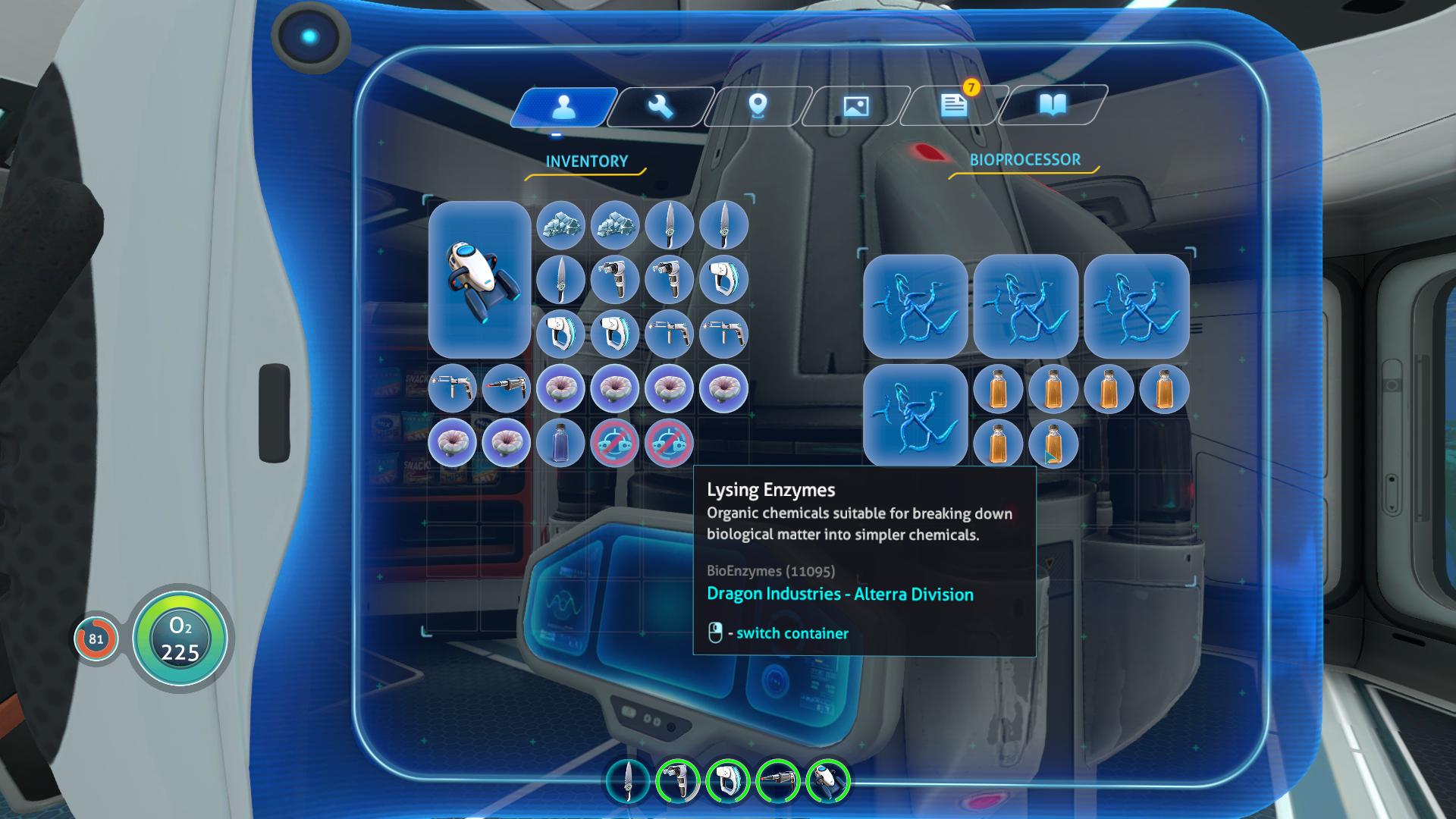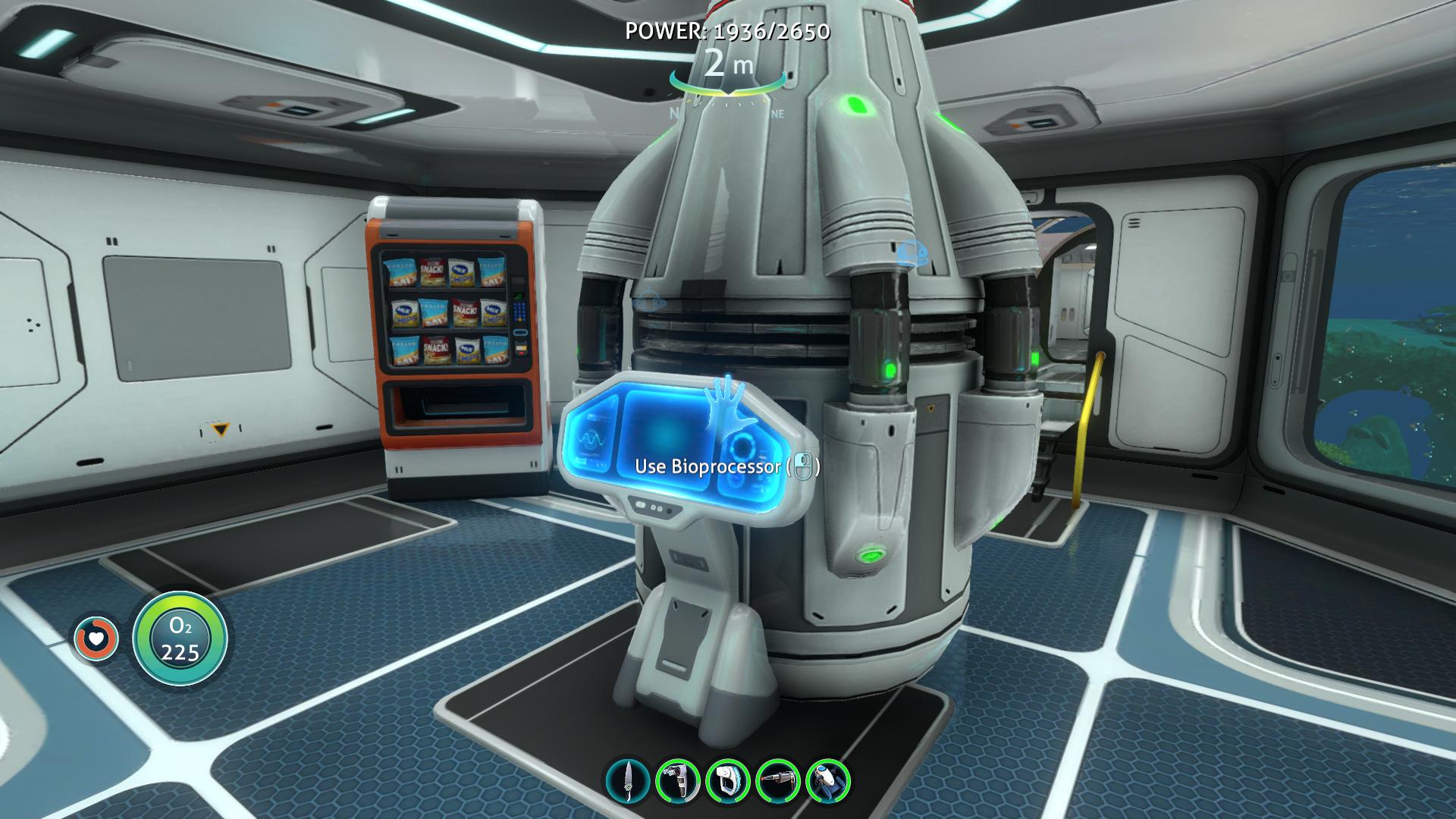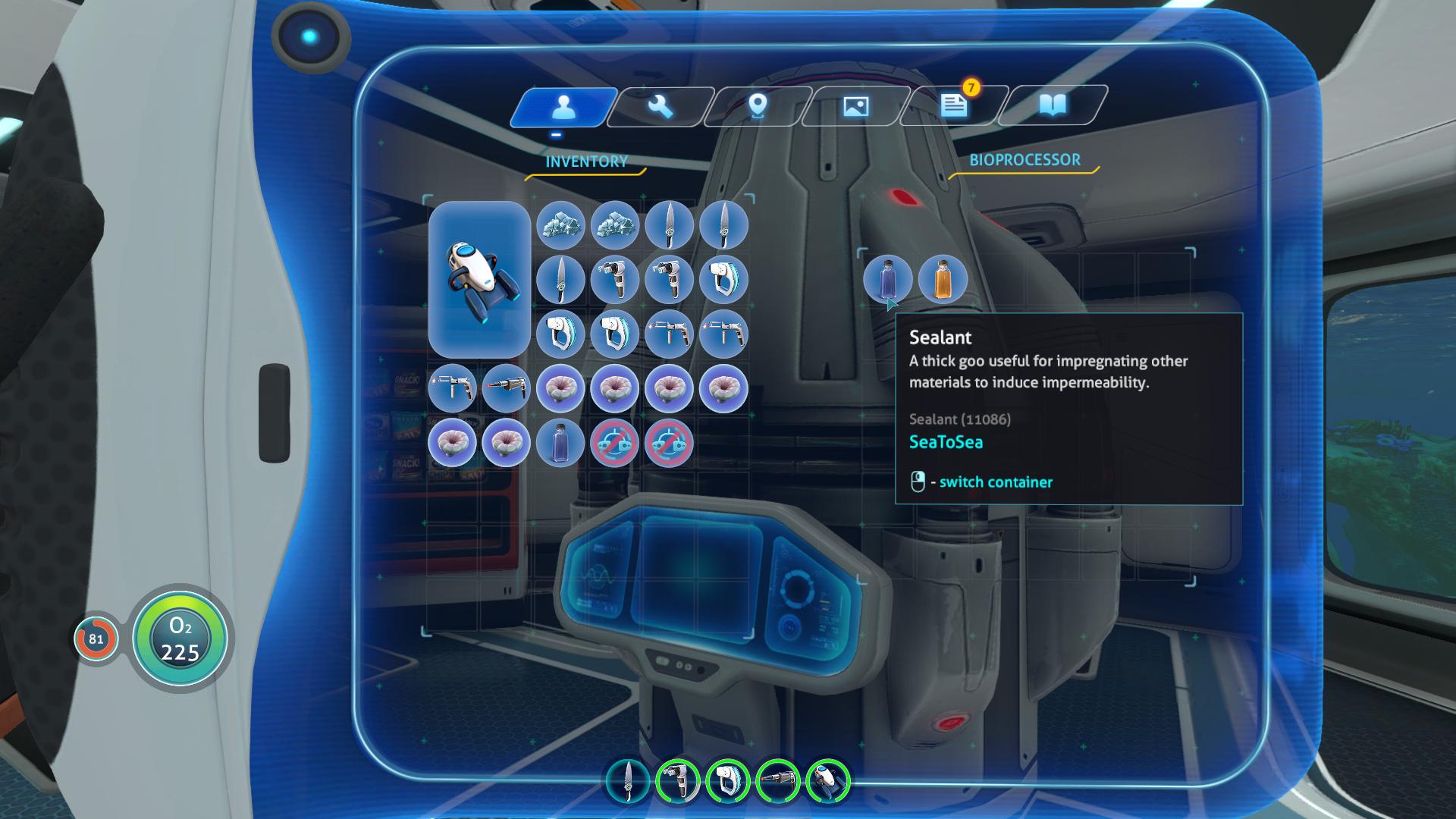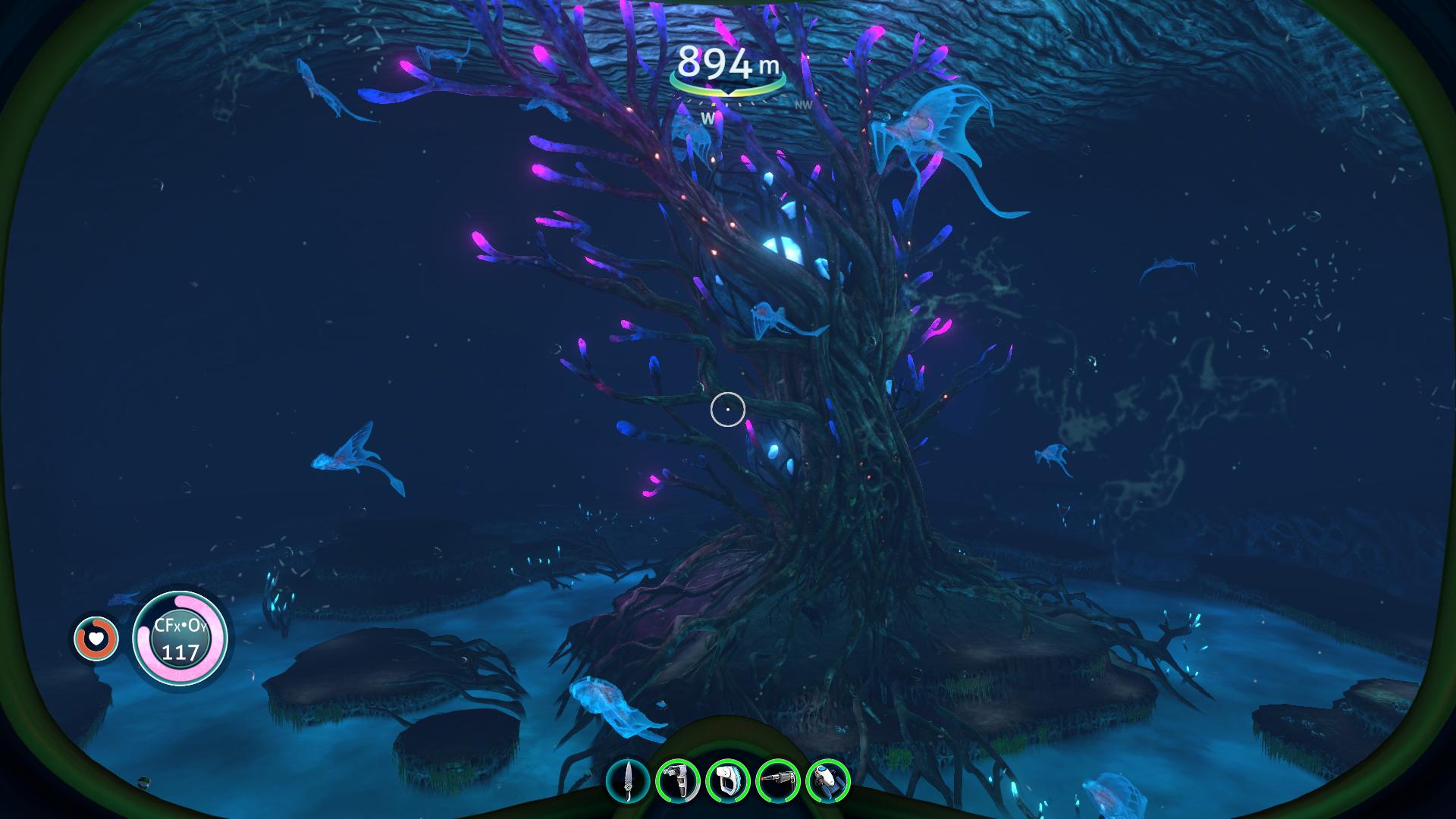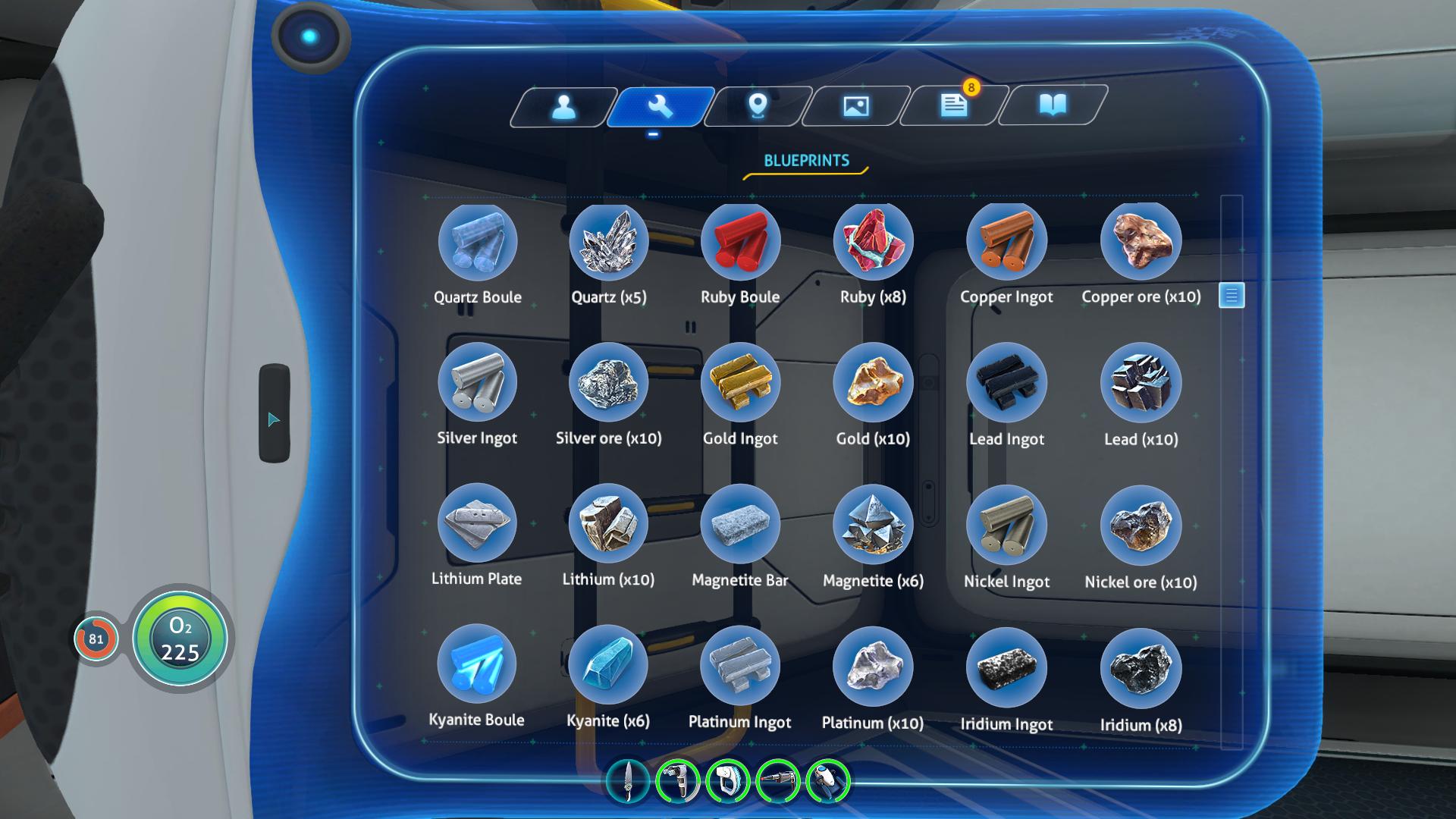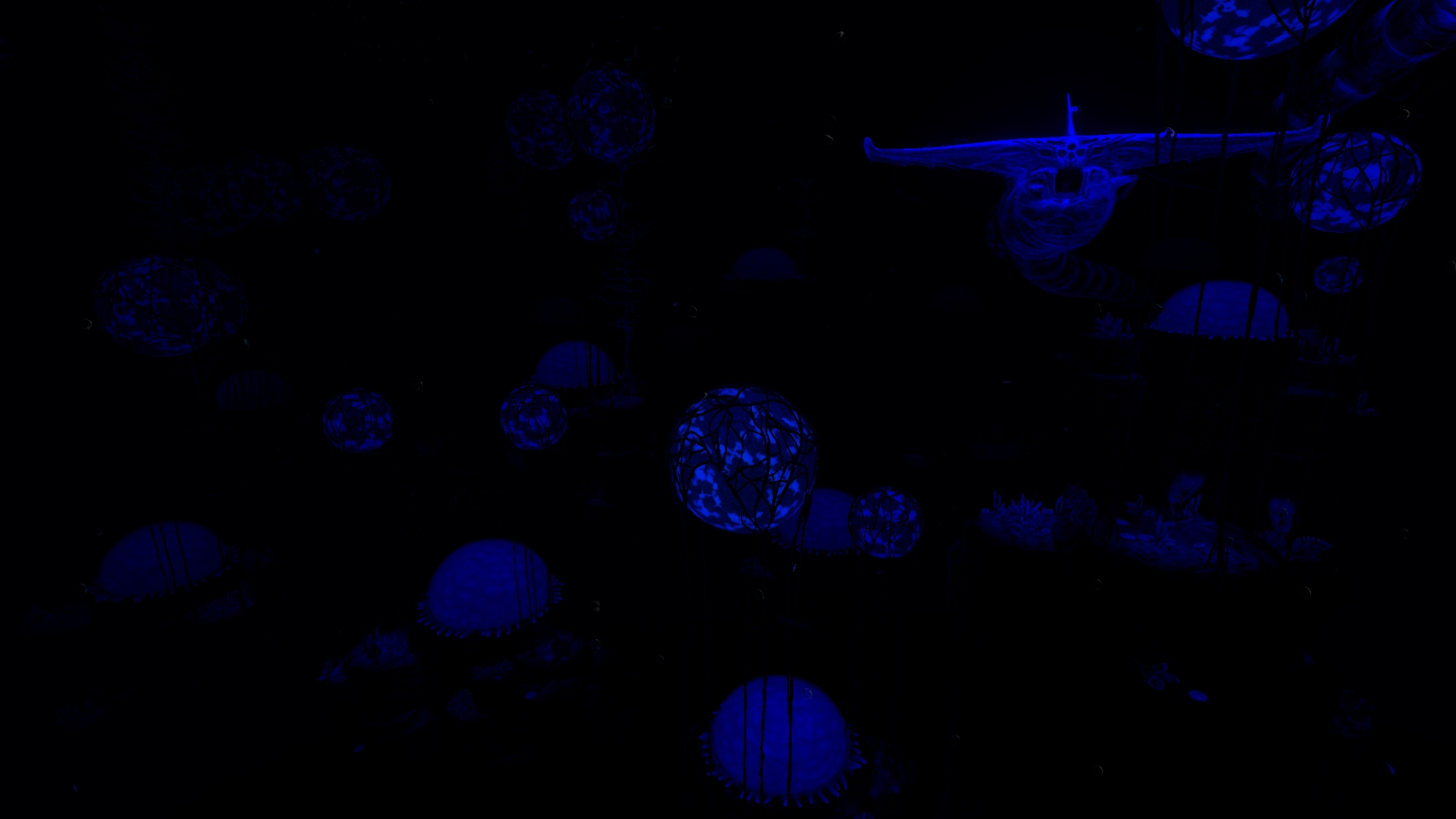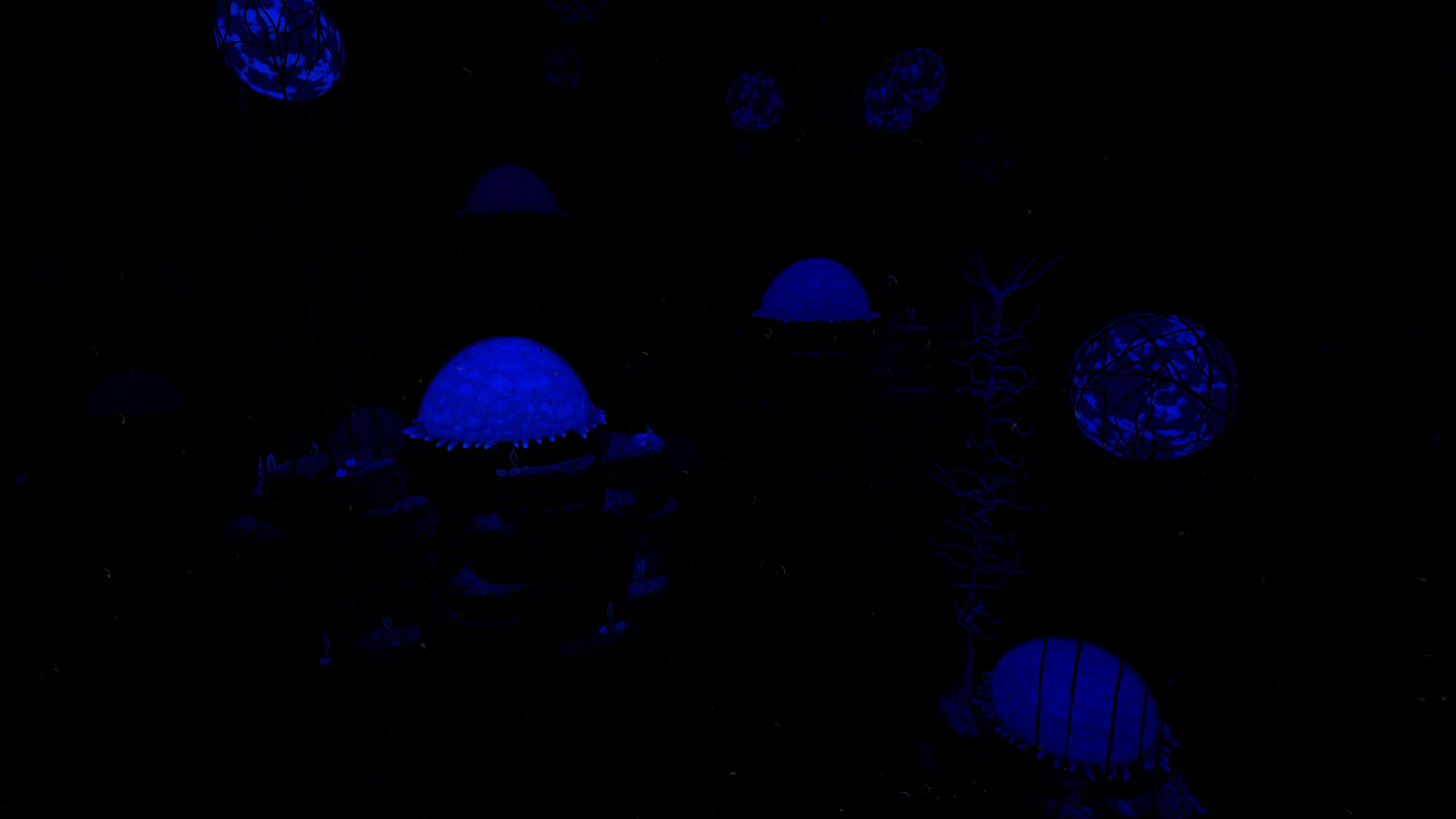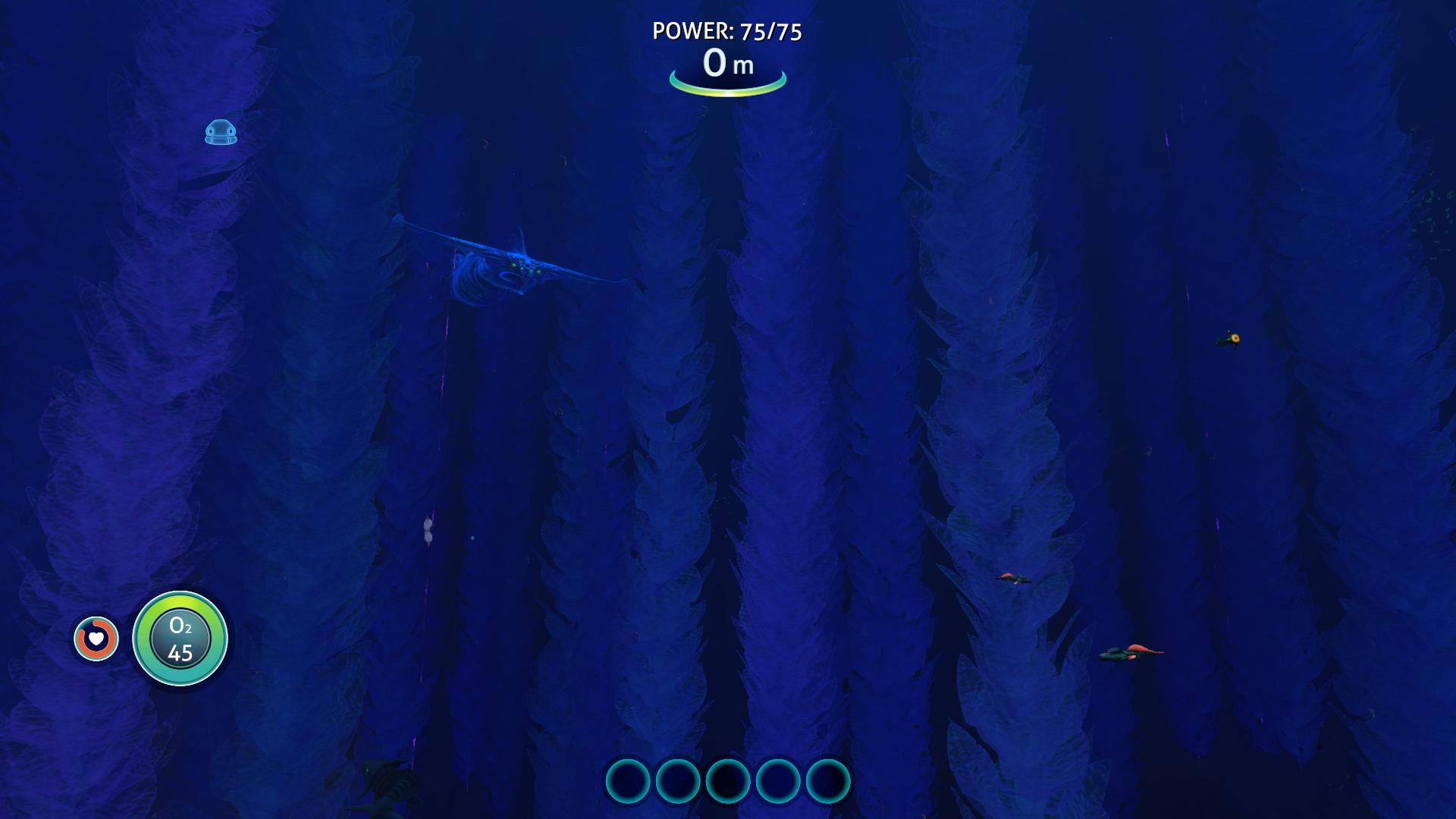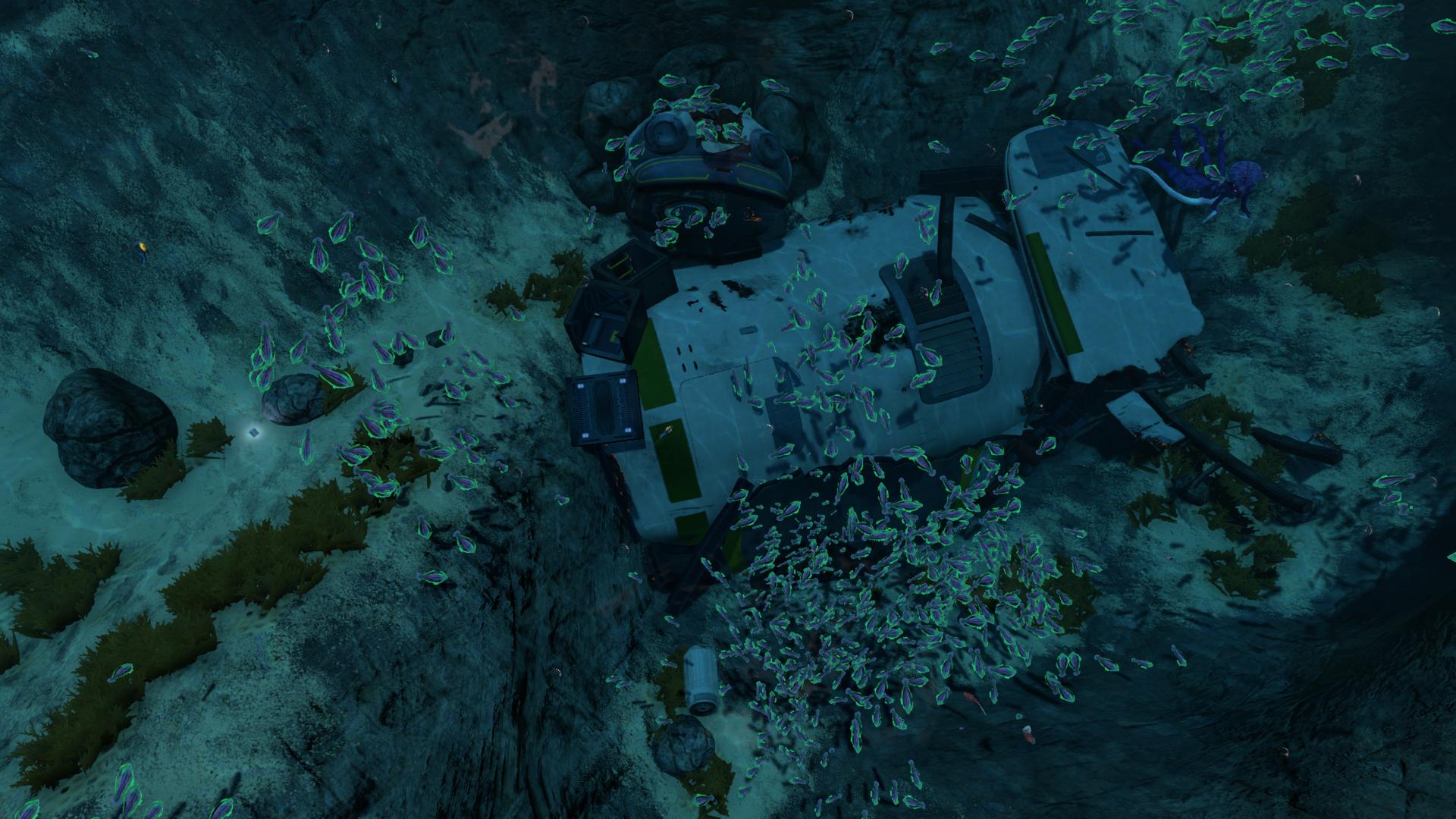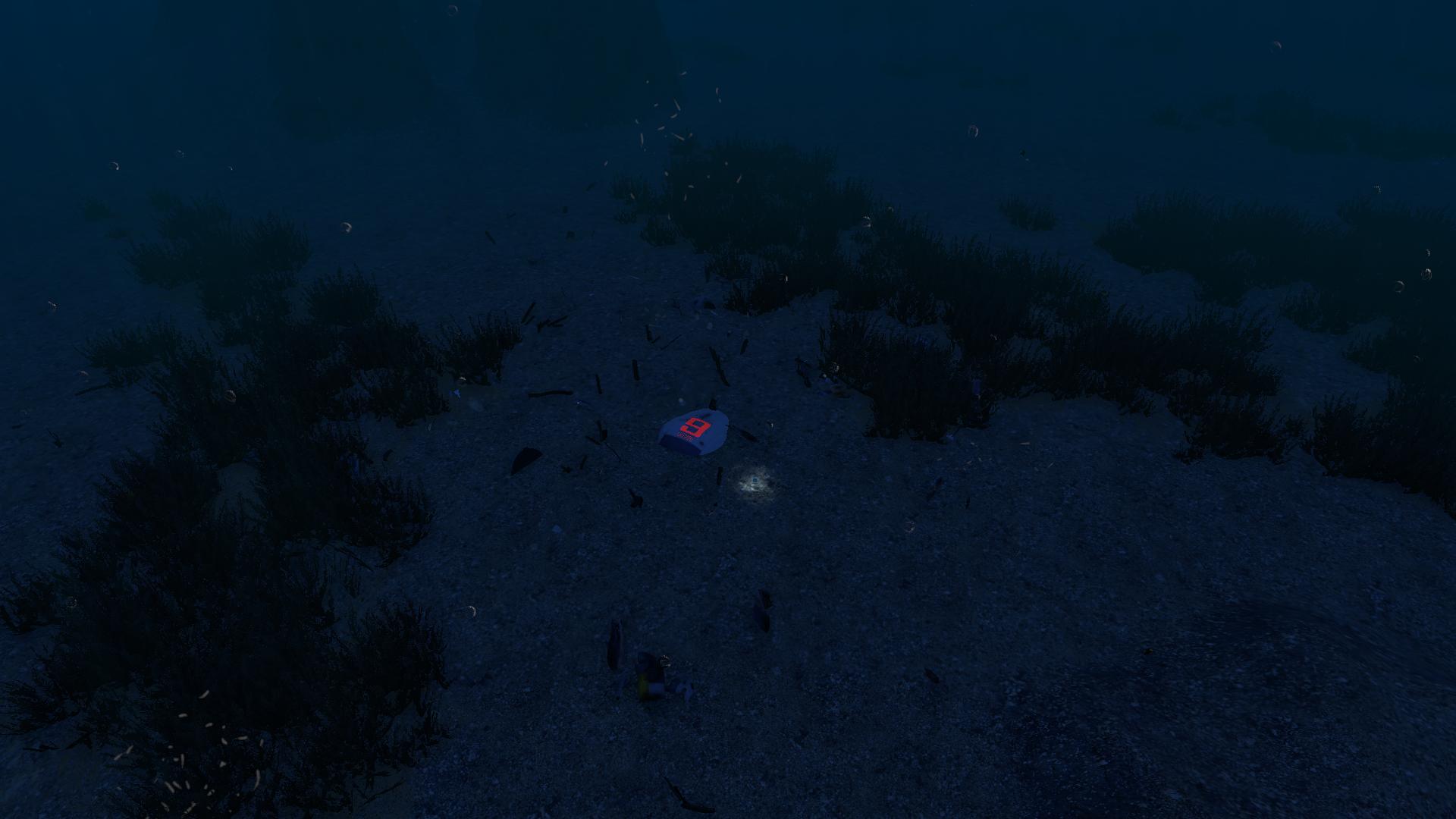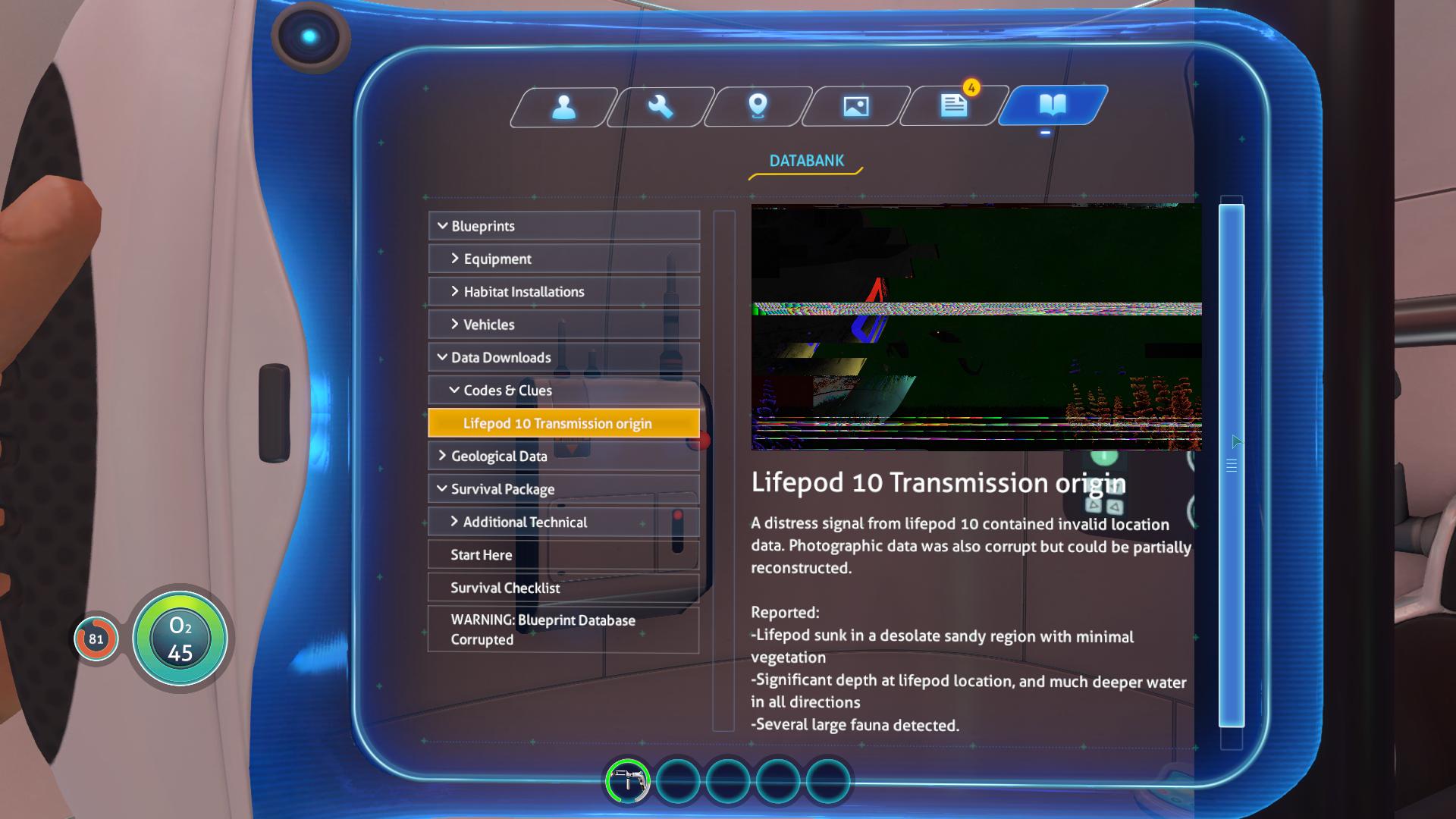General
Sea to Sea (abbreviated C2C) is a very large progression and exploration expansion mod for Subnautica, designed to dramatically expand and extend the gameplay of a typical playthrough, both in terms of duration and amount of used content.This is done by making many more regions of the map and game mechanics necessary for the core progression (both story completion and escape in the Neptune rocket), primarily by adding location-unique resources, blueprints, items, or knowledge, and situational needs for those resources, tools, or knowledge.
Sea to Sea aims to preserve the original gameplay as much as possible, building upon it rather than replacing it. As such, a C2C playthrough should still have strong thematic similarities, and a nearly-identical narrative experience, to that of the vanilla game.
This page details changes to vanilla progression, and will contain many unmarked spoilers of locations, features, and their related story elements!
Exploring the Ocean
The chief effect of Sea to Sea is to add the need for the player to have explored nearly the entire map, rather than only a small handful of regions absolutely required to progress the story or collect important resources. With the mod installed, you will find yourself traversing large areas of the map, either in search of points of interest or for resources which can only be found where certain environmental conditions exist. It is from this property that the mod derives its name; you will be crossing the entire ocean, from the Dunes to the Grand Reef to the northern Mountains, exploring reefs, cave systems, and more.In some cases, these points of interest or resources are ones already present in the vanilla game, but which normally have little reason to venture towards (for example wrecks with no blueprints that are not more easily found elsewhere); with Sea to Sea installed those will take on new importance, often with the addition of select new blueprint unlocks or new uses for the materials featured in the region. In other cases, a previously largely-useless area was given completely new content, such as a wreck or new material.
Additionally, several key story events and locations have been made absolutely required for progression, to ensure the player experiences the full story. This includes visiting all Degasi outposts and the Disease Research Facility, and witnessing the Sunbeam's landing attempt.
Using Mechanics
In addition to making use of much more of the map than is normally required, Sea to Sea makes the player utilize several game mechanics that are semi-frequently ignored.One of the most significant of these is the Seabase building mechanic; while this can be completely skipped for a vanilla playthrough, C2C requires seabases for several reasons, including to house and operate a recharging system for the liquid breathing apparatus - without which deep exploration is nearly impossible - and a new "Bioprocessor" crafting machine which has inherited most of the "plant to resource" type recipes.
Closely related to this is the agricultural mechanic, something encouraged by the vanilla game yet never required. With this mod, that encouragement is much much stronger.
Note that to encourage multiple bases across the map, the harvest yield of farmed flora in their native biomes has been doubled for all knife-type harvest plants and increased by 50% for "collectible fruit" plants.
Other examples of emphasizing game mechanics include extending the amount of time the player will spend with each "tier" of vehicle (including "no vehicle"), and increasing the need to interact with Sea Treaders for their...resource yields.
Bioprocessor
The bioprocessor is a processing (ie crafting, but automatic and over time) machine which is now the primary way you produce most plant- and animal-derived crafting products, such as benzene and hydrochloric acid, as well as several new ones including luminol and sealant. All of these work in the same general manner, taking some number of the raw input ingredient and some processing enzymes, and gradually consuming these enzymes until the final product is created.Some of the recipes are not replacements for the original recipes, but simply efficiency improvements. That is, for early-game items like lubricant, the original recipe continues to exist in a less efficient form, with the bioprocessor alternative being far more convenient once available.
The bioprocessor is quite power-hungry, necessitating substantiative power generation infrastructure, and as such is best placed in a base that is more than a simple minimalist outpost.
Liquid Breathing
With C2C installed, at extreme depths, your oxygen consumption will rise, even with a rebreather, and at greater depths still you will begin to suffer direct injury from the act of respiration. The solution to this is the liquid breathing system, which involves a special tank which supplies oxygen-saturated fluid through a compatible helmet. While this system is equipped, you will be immune to these pressure effects.The respiration tank has a main storage and a smaller "active" supply charge; the latter determines the maximum duration of your activities outside, as it can only be charged within a powered seabase or vehicle. In doing so, it drains from the main storage, which will eventually run empty. This main storage can only be refilled in a powered seabase equipped with the appropriate module, and requires consumable "breathing fluid", with each full charge being equivalent to one unit of said fluid (partial charge will only consume part of the value of the item).
As a final word of warning, while using the liquid breathing system, you will not be able to use outdoor air (seabase/cyclops air will still be accessible, and you will not consume precious breathing fluid while in such spaces), nor will you be able to eat. Furthermore, removing the device will completely empty your lungs of the fluid, and if not in an air-filled space you will rapidly asphyxiate.
Ingots
As a convenience feature, C2C adds reversible compressed ingots for most basic materials for which this would make sense, allowing you to save large quantities of inventory space, and for recipes to use larger quantities of materials without using too much inventory space to craft.Abyssal Stalkers
C2C adds a new subspecies of stalkers, found in much deeper biomes. This variant tends to remain around sea treaders, where they collect the metallic deposits unearthed by their movement. Caution in their presence is advised, as their possessive nature significantly exceeds that of their surface counterparts, especially for the most valuable metals.New Biomes
The mod adds three new biomes to the game, done to add a reason to venture to a new area, and to include some unique content not present at all in vanilla. All of these biomes' locations, exact natures, and contained treasures are a secret you will need to discover for yourself, but be warned that the feeling of danger within them is not without basis.Lifepods
Sea to Sea adds several new lifepods to the game, similar in design to the vanilla ones. The new ones serve the same purpose as those lifepods, to draw a player towards a general area, with the intent that they then explore the surrounding region and find the nearby POIs or other things of value.These pods, their inhabitants, and those characters' experiences in the hours or days after the Aurora crash will both add new "leaves" to the narrative of the game, as well as serve a major role in the player's progression as they encounter what remains. At the time of this writing, these ten characters' material legacy includes a half-dozen databoxes, and a suite of twelve new voice-acted PDAs to connect them to the main story, explain their posession of certain technologies, or provide hints to the player where to find or how to utilize valuable items or resources, or how to overcome some obstacle.
Puzzle
The hints mentioned above are not idle. In several cases, the player will be presented with a barrier to their progression or exploration, but not given any explicit instruction on how to surpass it; it is left to the player to make the connections between the pieces of knowledge they have and synthesize potential solutions. This is similar in concept to the "connect the dots from the hints" puzzles seen in ChromatiCraft, though at a much smaller scale. The majority focus on determining either the location of some desired feature (resource, structure, or so on), or of the tools/actions needed to gain free access to a location that is otherwise inaccesible or unsurvivable.Environmental Hazards
Many of such "initially inaccessible/unsurvivable locations" are that way because of new dangers added to the oceans of 4546B, specifically to the environment in certain regions. Surmounting these will necessitate gaining specific equipment, tactics, knowledge, or all of the above, until which point the areas are - generally lethally - unable to be explored and exploited.These new hazards include but are very much not limited to:
- The effects of the toxic, hypersaline brine of the lost river is no longer solely confined to a narrow basin in the floor; though the effect remains by far the most pronounced under that surface, chemical diffusion has rendered all the water in the tunnels both aggressively toxic and extremely electrically conductive
- Water pressures at extreme depths now act upon a free-swimming player, resulting in severely shortened survival times unless mitigation efforts are employed
- Lava zone temperatures have been drastically increased, to the point where unprotected swimming is rapidly fatal, some regions are unsafe when outside of a vehicle regardless of equipment, and vehicles, if not retrofitted, will disastrously overheat
Hard Mode
One of the config options for C2C is "Hard Mode". This does not resemble hardcore mode, nor does it make the game harder in the traditional sense (for example it does not appreciably make survival any more difficult). "Hard mode" instead is perhaps more accurately termed "More aggressive progression enforcement, more mechanics to adapt to, and more strongly encourage the intended diversification in gameplay". That is, this option controls the intensity of some existing mechanics and the presence of the more punishing/controversial ones.The following are among the changes when enabling hard mode:
- Bioprocessor power cost increased 2.5x, to require more robust power infrastructure
- Oxygen consumption at extreme depths rises more dramatically
- More fragments are required for many core technologies
- Vehicles now take increased crush damage the farther below the depth limit they go
- Solar power falls off faster with depth, encouraging other power sources
- Reduced hand-collectible mercury spawn rate, making prawn use more necessary
- Liquid breathing lasts only 2/3 as long per full recharge (main base-refilled tank, not supply tank)
- Abyssal stalker avarice increased
- Power cell charger uses 50% more power
- Increased overheating rate for vehicles in appropriate environments
- Sonar "noise" significantly increased
- Seamoth electrical defense is now only unlocked after an incident where it would have been useful
- Reduced spawn rate of some rare renewable resources
- Increased cost of some recipes
- Reduced base hull integrity boost from some modules
- Lantern tree growth rate reduced
- ACU waste generation rate reduced
- Stalker teeth require being found naturally before being detectable via the scanner room
- Reduced lumen oil spawn rate and lifespan, and increased its use in recipes
- Magnetic anomalies increased in intensity and frequency
Compatibility with Other Mods
SeaToSea is designed to be compatible with other mods, but as it is a major progression overhaul, and relies heavily on regional environmental effects, so mods which add alternate progression paths, or which circumvent these environmental effects, will seriously unbalance it. While it is still possible to play C2C alongside them, doing so is not going to resemble the designed gameplay, and this is not recommended.In particular, any of the following features are likely to be progression-breaking:
- Alternate recipes for crafting or methods of obtaining vanilla items (including some that are not obtainable in vanilla, such as mercury or some alien tablets)
- Remote resource collection (ie being able to collect resources without going there in person), especially for areas not yet entered in person
- Prawn-style drill arm modules available before/without the prawn suit (including seamoth arms)
- Mods that massively expand the number of modules you can install per vehicle
- Vehicle upgrades designed to negate normal limitations (eg higher tiers of seamoth depth modules, a cyclops module enabling permanent shield, a prawn teleportation module, or a much more powerful seamoth efficiency module)
- Any kind of player invulnerability
- Any kind of teleportation except maybe of the player between seabases
- Seabase parts or balance tweaks that massively buff the power of "basic" power generators, or add other "trivial" solutions to issues like farming or power generation
- Anything to disable fog/lighting
- Anything to duplicate or convert items (Equivalent-Exchange style)
Both CustomCraft and MoreSeamothDepth are known to be outright incompatible with C2C. The former crashes when mods remove vanilla recipes - as C2C does for things like hydrochloric acid and benzene (moving them to the bioprocessor), and the latter replaces entire sections of code that both DI and C2C rely on to function properly. These mods cannot be used alongside C2C.
Dependencies on Other Mods
Several of the supporting content and mechanics from C2C have been split into other mods, and as such C2C depends on the rest of my SN mods to function (the reverse is not true, ie they do not require C2C). As such, you will need to install all of them if you want to play with C2C.Also worth noting is that where those mods are configurable, some of these options are fixed or at least range-bounded when C2C is installed, to ensure the game balance remains within appropriate parameters.
C2C also depends on ECCLibrary, which can be found here.
C2C has an optional dependency on TerrainPatcher. The mod can be used without it, but TerrainPatcher is used to improve the terrain the custom biomes, greatly improving their aesthetics. TerrainPatcher can be downloaded here.
New Items
C2C adds many new items, both as raw resources and as crafting/intermediate materials:| Name | Type | Description | |
|---|---|---|---|
|
|
Abyssoclase | Raw Material | Small, dense crystals formed under extreme pressure, with trace amounts of exotic elements such as Tellurium. |
|
|
Avolite | Raw Material | An integral part of ship drives and phase gates. These crystals are not fully understood, but are known to only form in deep space. |
|
|
Azurite | Raw Material | Cu3(CO3)2(OH)2•8-. A luminous gemstone with exquisite optical properties and electromagnetic conductivity. |
|
|
Iridium | Raw Material | Ir. An exotic and dense metal not typically found in most geologic strata. |
|
|
Platinum | Raw Material | Pt. A dense, valuable, rare metal with extreme resistance to corrosion. In addition to being useful for creating alloys, it is also useful as a chemical catalyst with organic compounds. |
| Name | Type | Description | |
|---|---|---|---|
|
|
Alkali Vines | Plant Product | A plant with alkaline gel filling its structure. |
|
|
Deepvine | Plant Product | A tall deepwater plant, filling a similar role to creepvine in its local ecosystem. |
|
|
Eye Flame | Plant Product | The glowing core harvested from an eye flame. Generates a voltage when subjected to mechanical, thermal, or chemical stimulation. |
|
|
Pyropod Pitcher | Plant Product | Plant pods containing a complex mix of biological compounds, encased in a tough fibrous shell capable of withstanding high temperatures. |
|
|
Salve Bush | Plant Product | A plant with leaves possessing curative properties for physical, thermal, and chemical wounds. |
| Name | Type | Description | |
|---|---|---|---|
|
|
Amoeboid Samples | Crafting Item | Strands of colonial bacteria, evolved to leach minerals from rock. |
|
|
Bacterial Samples | Crafting Item | A quantity of bacteria, highly specialized for recombining organic compounds. |
|
|
Carboxylic Acid | Crafting Item | CH3(CH2)xCOOH. A dilute organic acid, suitable for use in basic electronics. |
|
|
Chlorine | Crafting Item | Cl. A highly poisonous gas which dissolves easily in water. Good for killing microorganisms. |
|
|
Digestive Enzymes | Crafting Item | Trace chemicals extracted from the digestive output of large animals. |
|
|
Electric Motor | Crafting Item | A midsize motor, capable of generating sufficient power to move sizeable machinery, pump fluids, or drive propulsion systems. |
|
|
Heat-sealed Fabric | Crafting Item | An advanced textile designed to not just insulate materials against chemical attack, but thermally isolate them as well. |
|
|
Honeycomb Composite Plating | Crafting Item | A strong lightweight panel with extremely low thermal conductivity, and very effective force and vibration absorption capabilities. |
|
|
Hull Plating | Crafting Item | Heavy armor for vehicles. |
|
|
Luminol | Crafting Item | C8H7N3O2. A luminous fluid, colorless in small amounts and pale blue in large quantities. |
|
|
Lysing Enzymes | Crafting Item | Organic chemicals suitable for breaking down biological matter into simpler chemicals. |
|
|
Microbiotic Gel | Crafting Item | A compound harvested from inside deepvine leaves, designed to support bacterial growth and metabolism. Will enhance the efficiency of biochemical processing. |
|
|
Nanolathing Drone | Crafting Item | A self-propelled drone equipped with a construction beam for constructing large objects from raw materials, similar to robotic builder tools. |
|
|
Neptune Rocket Fuel | Crafting Item | A chemical mixture capable of releasing extreme amounts of energy on demand. |
|
|
Rare Elements | Crafting Item | Trace quantities of rare metal and semimetal elements, used in advanced fabrication. |
|
|
Refractive Lens | Crafting Item | A lens with the ability to refract several kinds of energy and waves. |
|
|
Sealant | Crafting Item | A thick goo useful for impregnating other materials to induce impermeability. |
|
|
Sealed Fabric | Crafting Item | Fabric woven together and thoroughly saturated with sealing compounds. |
|
|
Shaped Azurite | Crafting Item | A more densely packed and energetically useful form of Azurite. |
|
|
Smart Polymer | Crafting Item | A flexible plastic material that remembers its original shape and returns to it when stress is released. |
|
|
Sulfuric Acid | Crafting Item | H2SO4. A concentrated inorganic acid. Useful to catalyze chemical reactions. |
|
|
Tank Wall | Crafting Item | A high-tech blend of materials with the right balance of elasticity and strength to contain reactive and dangerous rocket fuel. |
|
|
Volcanic Traces | Crafting Item | Small quantities of igneous materials, filtered from geyser output. |
| Name | Type | Description | |
|---|---|---|---|
|
|
Azurite Battery | Equipment | A better battery, with significantly greater storage density. Its material construction precludes being adapted into a vehicular power cell. |
|
|
Electrochemical Gloves | Equipment | Because wearing a protective suit but grabbing things with your bare hands would work about as well as punching out a reaper. |
|
|
Electrochemical Suit | Equipment | A suit made of molecularly impenetrable fabric. |
|
|
Liquid Breathing System | Equipment | A breathing apparatus that uses an oxygen-saturated perfluorocarbon liquid instead of air. |
|
|
Recirculation Mask | Equipment | A motorized face mask equipped with the ability to actively pump a breathing medium from storage and either recirculate it back to the tank or force waste gas out against very high pressures. |
|
|
Seamoth Heat Sink | Equipment | A consumable item for the heat sink module to operate. |
| Name | Type | Description | |
|---|---|---|---|
|
|
Acoustic Suppression Module | Modules | Greatly reduces the detectability of basic seamoth systems to passive listeners. Will not affect active echolocators, or creatures at close range. |
|
|
Cyclops Heat Dissipation Module | Modules | Provides the ability for the cyclops to shed excess heat in superheated environments, preventing serious overheating and fire. |
|
|
Electrical Sealant Module | Modules | Applies an insulating coating to the seamoth exterior, significantly reducing the power loss when in conductive environments. |
|
|
Seamoth Depth Module Mk4 | Modules | Raises depth limit to 1300m. |
|
|
Seamoth Heat Sink Module | Modules | Allows the seamoth to dump large quantities of heat quickly, helping it survive in extremely hot environments. Derived from spacecraft technology. |
|
|
Seamoth Propulsion Module | Modules | An upgrade for the seamoth propulsor that increases base speed and allows for short bursts of even higher speed. |
| Name | Type | Description | |
|---|---|---|---|
|
|
Breathing Fluid | Misc | CFx•Oy. A nontoxic solvent saturated with oxygen, suitable for liquid-based respiration. |
|
|
Nanowrap Bandages | Misc | A highly sophisticated wound dressing, capable of restoring far more health than a basic first aid kit, staunching any blood loss, and alleviating all symptoms of poisoning or other ongoing harming effects. |
Voice Credits
Thank you to the following people for helping provide voiceover work for the various radio/PDA log messages:- Hellexar
- waterlubber
- Clinton Westover
- Aloomanum_2
Configuration Settings
This mod contains several config options to modify values and behaviors - such as for balance or server safety concerns, or simply personal taste - to your preferences. Note that several settings may have bounds imposed on their values, either logically or explicitly; these can usually be seen in the actual settings files or ingame. These are listed in order found in the source code, which is generally the order in which they were added; They may be present in a different order ingame or in the configuration files.The settings for the mod, when installed, can be found in the mod's install folder.
Additional Exploration Prompts
Type: booleanCurrent Default Value:
true
Vanilla Value
Value:
false
Platinum Theft Chance
Type: floatCurrent Default Value:
0.5F
Vanilla Value
Value:
0.0F
Minimum Value
Value:
0.25F
Maximum Value
Value:
1.0F
Hard Mode
Type: booleanCurrent Default Value:
false
Vanilla Value
Value:
false
Enable Lifepod Drift
Type: booleanCurrent Default Value:
false
Vanilla Value
Value:
false


